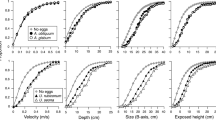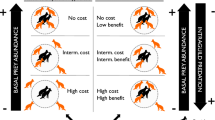Abstract
Food distribution is hypothesized to be important in determining the nature of female relationships within social groups of primates. When food limits female reproductive success, spatially clumped foods are expected to produce strong, linear dominance hierarchies within groups, whereas more spatially dispersed foods are expected to produce weaker or non-existent dominance hierarchies. The association between food distribution and competitive relationships presumably occurs because clumped foods are usurpable but dispersed foods are not. We examined the spatial distribution of food patches (trees) and patch size relative to feeding behavior and agonistic interactions in vervets and patas monkeys, two closely related and sympatric species that nonetheless differ in the strength of the female dominance hierarchy. Food patches of both patas monkeys and vervets were small in size and randomly distributed in Acacia drepanolobium habitat. In contrast, in A. xanthophloea woodland, the habitat type that was exclusively used by vervets, food patches were larger and more spatially clumped. These similarities and differences between and within species were correlated with similarities and differences in the strength and linearity of their dominance hierarchies. Patas monkeys and vervets in A. drepanolobium habitat had dominance hierarchies that were weakly defined because there were relatively few agonistic interactions between females. By contrast, in A. xanthophloea habitat, vervets had a stronger, linear dominance hierarchy characterized by a higher rate of agonistic interactions over food. The covariation of agonistic interactions with patch size is discussed in relation to depletion time, another characteristic that may covary with food distribution, and resource renewal rate, an important determinant of agonistic interactions in insectivorous birds, fishes, insects, and mammals.
Similar content being viewed by others
Author information
Authors and Affiliations
Additional information
Received: 18 February 2000 / Revised: 5 September 2000 / Accepted: 26 September 2000
Rights and permissions
About this article
Cite this article
Pruetz, J., Isbell, L. Correlations of food distribution and patch size with agonistic interactions in female vervets (Chlorocebus aethiops) and patas monkeys (Erythrocebus patas) living in simple habitats. Behav Ecol Sociobiol 49, 38–47 (2000). https://doi.org/10.1007/s002650000272
Issue Date:
DOI: https://doi.org/10.1007/s002650000272




